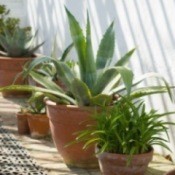 We usually think that growing succulents like cacti, yuccas, and agaves is reserved for gardeners living in the desert. Not so. The truth is, many species are fairly well adapted to growing outdoors-even in cooler conditions. Even if you live in the coldest of zones, succulents can be grown in pots and moved indoors for the winter.
We usually think that growing succulents like cacti, yuccas, and agaves is reserved for gardeners living in the desert. Not so. The truth is, many species are fairly well adapted to growing outdoors-even in cooler conditions. Even if you live in the coldest of zones, succulents can be grown in pots and moved indoors for the winter.
All cacti are succulents, but not all succulents are cacti. Over millions of years of evolution, these familiar plants have developed the ability to survive extremely well in an arid climate-their leaves have been reduced to spines, and their stems have been modified to take on the role of photosynthesis and store water. Cacti come in a variety of shapes and sizes, and under the right conditions, produce showy annual flowers ranging from pink, yellow, red, orange, and occasionally purple or white depending on the species.
Although typically thought of as a plant reserved for warm, arid climates, some native species grow as far north as Canada-even the Arctic Circle! If you live in a cooler zone, consider experimenting with more cold-hardy varieties like fire barrel (Ferocactus acanthodes), hedgehog (Echinocereus engelmannii), or grizzly bear prickly pear (Opuntia erinacea).
To avoid sunburn when transplanting cacti, make sure you position them so they are orientated in the same direction they were originally planted (south and southwest sides facing the sun). The sides of the plant previously facing the sun will have become toughened up and resistant to sunburn and scarring.Cacti have shallow root systems. To reduce the risk of causing damage to them, avoid disturbing the soil around the base the plants.
The thick, waxy stems of cacti are designed to minimize moisture loss, and over-watering them is a common mistake. It's okay to drench the soil each time you water, just let it dry out completely between watering (at least a week or more).
Ice is deadly-even to cold hardy cacti that can survive in deep snow. Cacti grown outdoors will need to be covered before a freezing rains begins. Of course the easiest way to meet their needs is to grow them in containers and move them to ideal locations as the seasons change.
These large ornamental succulents typically have large rosettes of thick fleshy leaves and depending on the species, may have numerous spines on the tips or margins of the leaves, or no spines at all. Agaves are not cousins to cacti, but are actually closely related to aloe plants. The dramatic, architectural appearance of the agave's leaves makes them popular landscaping plants.
If you're holding out for flowers however, patience will be a necessary virtue. Many varieties take anywhere from 10-50 years before sending up a mast full of short, tubular blossoms. This colorful finale usually appears in the plant's "final" season. Most varieties die immediately after flowering, although many will produce offsets from their base, which eventually develop into replacement plants.
Most agaves are only hardy to 40 F. In colder zones, grow them in pots outdoors and relocate them to the basement for the winter. Applying extra fertilizer will not help speed up flowering and may only end up damaging the plant. Plant varieties with spine-tipped leaves under ground-level windows can help to discourage would-be thieves. Agaves are naturally resistant to fire. In fire-prone areas, plant them around the perimeter of your property as an added layer of fire protection.
Unlike agaves, yucca plants will bloom year after year without dying. With its sword-shaped leaves and tall panicles of creamy white flowers, this low-maintenance plant can handle large swings in temperature (some species are hardy to 0 F) and less-than-ideal soil conditions. The diversity of forms and sizes available also offers gardeners lots of choices when it comes to using yuccas in the landscape.
Be careful not to under or over water young plants. Once established, plants are very drought tolerant and should be watered sparingly-only once every two weeks, unless faced with an extended heat wave with temperatures over 85 F.As leaves mature, it's normal for them to die back and turn brown. It may take a long time, but eventually the leaves will fall off on their own. If the plant looks unsightly in the meantime, use a sheers to cut off the leaves and keep it looking tidy. Yucca plants are light feeders. A one-time application of fertilizer in the spring should be sufficient for the year.
Each year I have hundreds of seed from the flower pods on my yucca. I've tried to plant them with no luck. Anyone know how to get them to grow? Thanks.
Hello Donna,
I can't exactly tell you how to grow them, I just know that where I live (Central Queensland coast, Australia), the darn things won't stop growing! They spread seed and it is a chore to get rid of the many young plants. They just seem to like to grow where ever they drop. They also sucker and though this is preferable to self seeding, I think if you want to grow the seeds yourself, don't treat the seeds like little princesses, as they seem to like more harsh conditions.
Good luck!
Vicki
When is the best time to plant yucca?
Hardiness Zone: 5a
By Mrgoodbar10 from IL
As long as the soil is workable you can plant it. Give it a soaking with transplant liquid, follow the directions on the label.